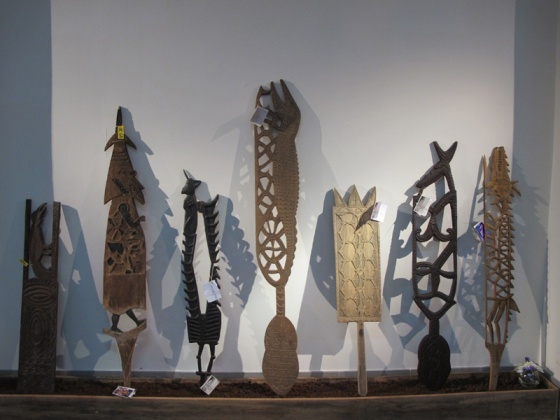
Saved: A set of wooden carvings made by the Kamoro tribe in Papua is on display at the Kamoro Arts Exhibition and Sale in Jakarta. (JP/Ika Krismantari)
The Kamoro Art Exhibition is back in the capital with a slightly bigger collection this year to give the public a better chance to participate in the preservation of a dying Papuan art form.
Two hundred wood carvings from the Kamoro tribe are featured in this year’s exhibition, Jina Muller, the event’s publicist, told The Jakarta Post on Wednesday.
Muller hopes more visitors will attend the exhibition this year and more will purchase from the collection, because the main purpose of the annual event is not only to create public awareness of Kamoro art but also to create a market to sustain the tradition that is dying out in the face of modernity.
The Kamoro woodcarving tradition, unlike that of its neighbor the Asmat, has been on the verge of extinction simply because there is no demand for it. Most locals only carve for ceremonies, and with the declining interest from the younger generation, the tradition is set to perish.
Responding to this problem, Muller and her husband Kal Muller have been organizing the exhibition and sale since 2007 in an attempt to make Kamoro art more accessible and therefore giving locals reasons to continue carving.
The couple purchases carvings and provides an initial payment to carvers; as soon as the pieces are sold they give the rest of the money to the craftsmen.
Forty-three-year-old Yosef Tiriyuka is one of the carvers who has enjoyed the benefit of such a program.
Scrubbing the surface of an unfinished 2-meter-long wooden carving in the back of the exhibition room, he shared how things had changed after the arrival of the Mullers.
“We used to only carve boats and mbitoro [a large totem-like pole carved and erected for initiation ceremonies], but now even the young ones also carve,” said Yosef.
He also mentioned that more children in his village are going to school and people have received a steady income due to proceeds from the exhibition.
Realizing the exhibition’s significant role in the Kamoro economy and cultural life, Jina Muller said she and her husband had been trying to widen the scope of the event.
She explained that previous exhibitions were held as closed events at different embassy residences in Jakarta. But since last year, with the support of US Ambassador to Indonesia Scot Marciel, the organizers were able to make the exhibition open to the public.
Yet despite all their efforts, Kal Muller, who has been engaging with the tribe for more 15 years, admitted that more work needs to be done to promote Papuan art among the Indonesian people.
“The main challenge that I am facing is to get Indonesian people interested in this and not only foreigners,” said the man, who has penned several books on Papua.
Apart from organizing the exhibition, Muller has also been cooperating with other institutions like
the University of Indonesia and major publishing group Kompas to further promote the Kamoro woodcarving tradition and culture in order to help it survive.
But still he acknowledged that the tradition is barely managing to survive at the moment. That is why the man says he has been thinking of a new strategy that may work for Indonesians.
“Someone told me I need a very popular Indonesian movie star or TV star to say ‘Hey this is good stuff’ and Indonesians will go and say Okay, okay we are going to buy this stuff’,” he said of his plan.
Despite this seemingly brilliant solution, would not it be nice to see local celebrities working voluntarily to promote Papuan tradition, or more than that, ordinary Indonesians taking initial steps to protect local culture?
Kamoro Art Exhibition and Sale
The American Club
Jl. Brawijaya IV No. 20
Kebayoran Baru
South Jakarta
Nov. 9, 2012 from 12:30 p.m. to 4:30 p.m.
Nov. 10-11, 2012 from 10:30 p.m. to 4:30 p.m.
